How do you get to the art fair?
(a) bike?
(b) Beemer?
(c) the Bentley?
[photo]

The Ann Arbor Downtown Development Authority board has approved a resolution that expresses notional support, but not does not commit any funding, for the third phase of a study for a high-capacity transportation system – stretching from US-23 and Plymouth southward along Plymouth to State Street, then further south to I-94. The third phase of the study will be an environmental review.
DDA board action came at its April 2, 2014 meeting. The resolution of support will be used as part of an application, due April 28, for a U.S. Department of Transportation TIGER 2014 (Transportation Investment Generating Economic Recovery) grant.
The lead agency for the study, which is now in its second phase, is the Ann Arbor Area Transportation Authority. This … [Full Story]
Ann Arbor Downtown Development Authority board meeting (March 5, 2014): Three main business items were approved by the board: submission of its FY 2015 budget to the city council, award of a $50,000 management incentive to its parking management contractor, and a resolution pledging to maintain or increase DDA funding of transportation programs, if the May 6, 2014 AAATA transit millage is approved by voters.
The proposed budget shows $19.3 million in revenues from the public parking system and $4.8 million in tax increment finance capture. Overall, it shows $24,237,186 in revenues against $26,531,972 in expenses. The use of fund balance to cover the difference leaves the DDA with an estimated fund balance at the end of FY 2015 of about $3.3 million. FY 2015 runs from July 1, 2014 through June 30, 2015. [FY 2015 DDA budget breakdown]
The expenses include $353,344 in salaries and $245,894 in fringe benefits for four staff members, $7,075,571 in payments to Republic Parking for management of the public parking system, and $2.1 million for parking facility maintenance. Accounting for $3.19 million of the expenses is a payment made to the city of Ann Arbor, equal to 17% of the gross revenues to the public parking system.
Included in the budget is a $200,000 grant to the Ann Arbor Housing Commission – as part of a $600,000 request from AAHAC to support improvements to Baker Commons and Miller Manor.
The budget also includes $676,000 for support of the getDowntown program. The board also approved a resolution that pledged to work toward maintaining or increasing the DDA’s support for transportation programs. That resolution came in the context of an approaching May 6, 2014 transit millage ballot question. The 0.7 mill tax was placed on a May 6 ballot by the Ann Arbor Area Transportation Authority board on Feb. 20, 2014. The tax would be levied by the AAATA only if it wins a majority of support among voters across its three member jurisdictions: the city of Ann Arbor, the city of Ypsilanti and Ypsilanti Township. The DDA board resolution came in part as a response to the fact that the DDA will be capturing a portion of the new millage under its tax increment finance (TIF) funding mechanism.
The board also approved the award to Republic Parking of the full $50,000 annual discretionary management incentive. Republic Parking’s contract with the Ann Arbor DDA covers just actual costs, but also includes a $200,000 annual management fee. Of the $200,000 management fee, $50,000 is awarded to Republic on a discretionary basis. It was last year, at the board’s March 6, 2013 meeting, when the DDA board decided for the first time in five years to award the full $50,000 of the incentive. The year before, at its Feb. 1, 2012 meeting, the board determined to award $45,000 of the discretionary amount. That matched the same figure awarded in 2011, 2010 and 2009.
The board also heard the usual range of reports from committees as well as public commentary. A highlight of announcements included the upcoming closure of the surface parking facility at the old Y lot, as the city-owned property is sold to hotelier Dennis Dahlmann. The closing is expected sometime between March 13-15. The lot is located on William Street between Fourth and Fifth avenues, across from the downtown library and south of the Blake Transit Center. [Full Story]
At their Jan. 28, 2014 meeting, Ann Arbor park advisory commissioners recommended purchasing two 15-seat GMC Savana passenger vans from Red Holman GMC in Oakland County for a total of $50,212.
According to a parks staff memo, the city’s current fleet of seven 15-passenger vans was unable to keep up with the increasing shuttle transportation demands for Huron River trips in 2013, following the opening of Argo Cascades. More vans are needed to transport people on these trips, which start at the Argo livery and end at Gallup Park. One van in the fleet needs to be replaced. The other van purchase would increase the total van fleet to eight.
The new vans will be purchased out of the FY 2014 parks & recreation … [Full Story]
Continued study of alternative sites and conceptual design for a possible new Amtrak station for the city of Ann Arbor has been given approval by the city council. The vote, taken at the council’s Oct. 21, 2013 meeting, was unanimous.
The specific action taken by the council was to approve a contract with URS Corporation Inc. (URS) to conduct the Ann Arbor Station project environmental review. The total approved for the Ann Arbor Station contract by the council – which will cover … [Full Story]
Two major transportation issues are currently scheduled to appear on the Ann Arbor city council’s Oct. 21, 2013 agenda: (1) consideration of a resolution admitting Ypsilanti Township into the Ann Arbor Area Transportation Authority; and (2) a resolution awarding a contract to URS Corporation Inc. (URS) for the environmental review related to the Ann Arbor Station.
Transportation is also a highlight of the council’s work session on Monday, Oct. 14 starting at 7 p.m. The session will feature a briefing on regional transportation issues, including the topic of admitting Ypsilanti Township into the AAATA. Council work sessions are broadcast on Channel 16, which is also streamed online by Community Television Network (CTN).
At its Sept. 26, 2013 meeting, the AAATA board voted to … [Full Story]
Patrons at the Ann Arbor art fairs – which take place from July 17-20, 2013 – will again this year be able to ride a “trolley” shuttle bus service that circulates to the four different fair areas. [.pdf of the "trolley" route]
In action taken by the board of the Ann Arbor Downtown Development Authority at its July 3, 2013 meeting, $10,000 was allocated to defray the cost of operating the shuttle service. The Ann Arbor Convention and Visitors Bureau is contributing an additional $10,000. The DDA board resolution describes the annual operating cost of the art fair trolley as more than $25,000.
This brief was filed from the DDA offices at 150 S. Fifth Ave., Suite 301 where the … [Full Story]
At its July 1, 2013 meeting, the Ann Arbor city council will consider and likely adopt a new set of rules affecting meeting mechanics.

Flags flying over Pittsfield Township Hall on June 27, 2013. Political winds were also blowing (indoors, and not quite as hard) at a meeting also attended by representatives of Ypsilanti, Ann Arbor, Saline and Ypsilanti Township – on “urban core” transportation.
Easiest to quantify are rule changes affecting speaking time limits. For the public, the time per speaking turn will drop across the board – from three minutes to two minutes. For each councilmember, the total speaking time per item of debate will drop from eight minutes to five minutes.
Whether those quantitative changes will have a qualitative impact on the city council’s meetings is an open question. More likely to have a positive qualitative effect, I think, is a rules change that adds an opportunity for public commentary at the council’s work sessions.
The exchange of viewpoints among councilmembers during those work sessions is currently tentative and spare, often in the guise of merely asking a question. That’s because Michigan’s Open Meetings Act does not allow a gathering of councilmembers to include deliberations, unless an opportunity is provided for the public to address the council. By giving the public an opportunity to comment during those sessions, councilmembers will be free to engage in unfettered exchanges of viewpoint. And that will be a benefit to the public and to the city staff.
However, in this column I’d like to focus on a different proposed amendment to the rules – one that could potentially improve local governance, not just change what happens at city council meetings.
Among the rules changes is one that would move the mayor’s communications from a slot on the meeting agenda after all regular business to one that precedes all regular business. That’s important because the mayor’s communications include nominations to boards and commissions. That agenda slot also includes the council’s vote to confirm those appointments – typically at the following council meeting. This rule change will ensure that interested residents will not need to stay up until midnight or 3 a.m. – or whenever the council finishes its voting business – to find out who the mayor has nominated.
And that bit of extra spotlight on the nominations could lead to an interest on the part of the mayor – whoever might hold that position – in offering a better explanation of each nomination. It’s reasonable, I think, to get a better explanation than the kind we typically hear – generally a brief comment at the end of a meeting, when everyone is barely awake.
For example: What is it about the nominee’s philosophical orientation to the board’s subject matter that makes this person a good fit for the position? How was it that this person came to be chosen? Who is this person? To the extent that residents are given a clearer idea of how and why nominations are made to boards and commissions, that might increase the inclination of other qualified residents to offer their service.
In the near future, nominations to two significant boards will be made by mayor John Hieftje. One nomination is needed due to the expansion of the Ann Arbor Area Transportation Authority’s board – from seven to nine members. Of the two additional seats, the city of Ypsilanti will make one appointment. For that seat, Ypsilanti mayor Paul Schreiber will be nominating Gillian Ream at the Ypsilanti council’s July 2 meeting. Hieftje will be making the nomination for the other new AAATA seat. He will also need to make nominations to replace two departing members from the board of the Ann Arbor Downtown Development Authority – Leah Gunn and Newcombe Clark.
The public policy areas of the two boards overlap – not just because transportation is related to land use and development. The overlap also stems from the fact that the DDA manages the city’s public parking system, and the availability of parking is integral to the area’s transportation system.
So in this column, I’d like to sketch out some current policy issues to be faced by new appointees to the boards of these organizations. For the AAATA board, a pressing question will be: Should we ask voters to approve an additional transportation millage in November 2013? For the DDA board, an ongoing question will be: What’s an appropriate balance among users of the parking system – downtown residents, retail customers, and employees of downtown businesses?
But first, a little history. [Full Story]
Ann Arbor Downtown Development Authority board meeting (Nov. 7, 2012): The board’s first-Wednesday monthly noon meeting often falls the day after Election Day, as it did this year. That left executive director of the DDA Susan Pollay with less sleep than others – as she did not conclude her duties on one of the city’s 11 absent voter count boards until around 3 a.m.
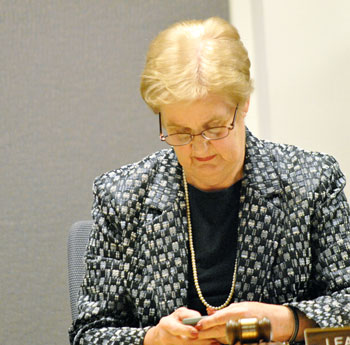
DDA board chair Leah Gunn checks her cell phone before the start of the Nov. 7 meeting. (Photos by the writer.)
But the DDA board’s agenda was relatively light. It did not include any voting items, and consisted of a series of reports and commentary – some of it in preparation for the board’s upcoming annual retreat on Nov. 16.
Sketching out the retreat for the board, Pollay told them that for the first time in the nearly 17 years she’s served as executive director, there is no “next big project.”
A big project the DDA is just completing is the construction of the Library Lane underground parking garage on South Fifth Avenue. The construction bills for that project were included in last year’s (FY 2012) budget, but not all of them came in by year’s end. So as board member Roger Hewitt reported, the first quarter financial statements for this year include bills that were originally budgeted for last year. When all the construction bills are paid, a budget adjustment will be made, he said. In any case, he characterized the DDA’s financial position as strong.
The board was also briefed on the public parking system, which the DDA manages under a contract with the city of Ann Arbor. Chronicle coverage of the parking report came earlier in a preview article.
The board got an update on two projects recently proposed for the downtown, which have now undergone review by the city’s design review board, and for which citizen participation meetings have been held: 624 Church Street, next to Pizza House; and 413 E. Huron at Division Street. The next formal step for both of those projects will be submission to the Ann Arbor planning commission.
At the meeting it was reported that the developer of the 413 E. Huron project also has a possible interest in the city-owned properties that are included in the scope of the Connecting William Street (CWS) planning project, which the DDA is overseeing. The board got an update on CWS – the process is expected to result in a recommendation made to the city council before the end of the year.
The board also got an update on the review of an issue that mayor John Hieftje has pushed the DDA to address for the last three years: bicycle riding on downtown sidewalks. For now it looks like the DDA is not likely to move forward on that issue, until the problem is more clearly defined. [Full Story]
The study of a transportation connector between the northeast and south sides of Ann Arbor has received the final nudge forward it needed to get started – a $30,000 contribution from the city of Ann Arbor. The council approved the study of the connector corridor at its Oct. 15, 2012 meeting.
The council actually voted twice on the issue at the same meeting. On the first vote, the resolution failed. But a few minutes later, Marcia Higgins (Ward 4) – who had initially voted against it – asked for reconsideration of the vote, and she changed her vote to support it, as did Mike Anglin (Ward 5).
Voting against the proposal on the second and final vote, which got more than the eight … [Full Story]
Ann Arbor Public Schools board of education (May 9, 2012): One of the major tasks of the board of education is setting the budget, the other is setting policy. The May 9 agenda was primarily policy-focused, but discussion on the budget found its way into most sections of the meeting.
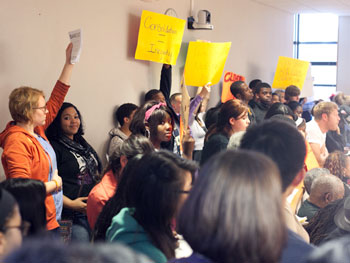
Supporters of the Roberto Clemente Student Development Center filled the board room for the May 9 meeting. (Photos by Monet Tiedemann.)
Sentiments expressed during a heated public commentary section were later echoed during agenda planning, as two of the board trustees questioned administrative work being done behind the scenes to prepare for possible budget reductions. The budget does not need to be approved by the board until June 30. A second public forum on the budget will be held on May 14 at 6:30 p.m. in the Huron High School cafeteria.
Several speakers at the May 9 meeting thanked the community for passage of the technology bond millage two days earlier.
Also at the May 9 meeting, trustees considered approving two new easements with the city of Ann Arbor, and awarded a set of bids for physical properties work. They also took a first look at the district’s new anti-bullying policy, as well as a set of other policy updates presented by AAPS administration.
Finally the board reviewed the proposed 2012-13 budget of the Washtenaw Intermediate School District (WISD), and shared its concerns about it. Local school boards are required by law to review the WISD’s budget, but have no vote in its actual approval. [Full Story]
Ann Arbor Public Schools Board of Education Regular Meeting/Committee of the Whole (April 18, 2012): After quickly approving two items in a regular meeting, the AAPS school board recessed to a committee meeting to discuss informally proposed reductions to the fiscal year 2012-13 budget. The district faces a $17.8 million deficit for the coming year.
Trustees discussed possible staffing cuts, reductions to transportation services and discretionary budgets, the restructuring of alternative high school programs, and the elimination of some extracurricular funding. AAPS administration is currently relying on $6 million worth of projected revenue enhancements to cover a chunk of the deficit. The remaining deficit is proposed to be covered through a combination of cuts and use of fund balance – summarized in three different plans: A, B and C.
Plan A has the least amount of cuts and the most use of fund balance, but still calls for a reduction in staff by 32 full-time positions, the elimination of some busing services, and the closure or merging of one of the district’s alternative high schools. Plans B and C have progressively greater cuts and less use of fund balance.
A formal presentation will be made on proposed budget reductions at the next regular board meeting, this Wednesday, April 25, with community forums and public hearings to follow in May. Board president Deb Mexicotte said at the meeting that the board will pass a finalized FY 2012-13 budget in June.
After the jump, the specifics of Plans A, B and C are laid out it detail. [Full Story]
Ann Arbor Public Schools Board of Education regular meeting (March 7, 2012): Trustees of the Ann Arbor Public Schools (AAPS) school board fast-tracked the approval of another 170 schools-of-choice slots in the district, allowing students from within Washtenaw County to transfer to AAPS for the remainder of their K-12 education.
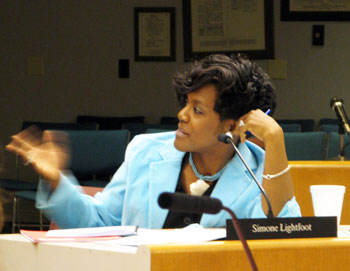
AAPS trustee Simone Lightfoot at the March 7 meeting. She was not alone in expressing her dissatisfaction with the transportation services being provided by Washtenaw Intermediate School District. (Photo by the writer.)
Under Michigan’s schools-of-choice legislation, local school districts can enroll these nonresident students without having to obtain approval from the district in which students reside.
So schools-of-choice students bring their state per-pupil allocation with them to AAPS. If all 170 seats are filled, the district will gain approximately $1.19 million in additional revenue.
The March 7 board meeting included discussions of the district’s transportation options, staffing process, and fund balance as trustees brace for budget recommendations to be brought to them by AAPS administration by the end of March.
Trustees expressed dissatisfaction with its transportation services, which it receives from the Washtenaw Intermediate School District as part of a consortium of other districts. [Full Story]
How do Ann Arbor’s land use policies affect where people live and work, and the way they get from one place to another? What is the city doing to support sustainable approaches?

Joe Grengs, a University of Michigan associate professor of urban and regional planning, and Ginny Trocchio, who manages the city's greenbelt program, were among the speakers at a Feb. 9 sustainability forum.
Issues of land use and accessibility were the topic of a sustainability forum on Feb. 9, the second in a series that’s part of a broader city sustainability initiative. During the forum, city staff also unveiled a set of draft goals for Ann Arbor related to four general sustainability themes: Resource management; land use and access; climate and energy; and community.
Wendy Rampson, head of the city’s planning staff, told the audience that the 15 draft goals were extracted from more than 200 that had been identified in existing city planning documents. The hope is to reach consensus on these sustainability goals, then present them to the city council as possible amendments to the city’s master plan.
Speakers at the Feb. 9 forum included Joe Grengs, a University of Michigan associate professor of urban and regional planning; Susan Pollay, executive director of the Ann Arbor Downtown Development Authority; Eli Cooper, the city’s transportation program manager and member of the Ann Arbor Transportation Authority board; Jeff Kahan of the city’s planning staff; Ginny Trocchio, who manages the city’s greenbelt program; and Evan Pratt of the city’s planning commission.
A Q&A followed presentations by the speakers and covered a wide range of topics, including thoughts on the proposed Fuller Road Station. The following day, Feb. 10, the city and University of Michigan announced plans to halt the initial phase of that controversial project – a large parking structure near the UM medical campus.
The topics of the series of forums reflect four general sustainability themes: Resource management; land use and access; climate and energy; and community. The first forum, held in January, focused on resource management, including water, solid waste, the urban forest and natural areas.
All forums are held at the downtown Ann Arbor District Library and are being videotaped by AADL staff. The videos will be posted on the library’s website. Additional background on the Ann Arbor sustainability initiative is on the city’s website. See also Chronicle coverage: “Building a Sustainable Ann Arbor,” and an update on the project given at the November 2011 park advisory commission meeting. [Full Story]
Ann Arbor Public Schools Board of Education regular meeting (Feb. 8, 2012): At a meeting of the AAPS board of education with a relatively light agenda, trustees discussed the anticipated state education funding incentives revealed by Gov. Rick Snyder last week.

AAPS board member Christine Stead. Across the table from Stead (and Deb Mexicotte, who's seated to Stead's right out of the frame) are board members Glenn Nelson and Susan Baskett. (Photos by the writer.)
Contending that any increases would do little to rectify the compounding losses of funding since the passage of Proposal A, trustee Andy Thomas summarized the state’s budget plan as: “One hand giveth and the other hand taketh away.”
Trustees also agreed to move to a paperless system of board documents. In other business, the board agreed to change the district’s liability insurance carrier, and joined an emerging advocacy group – the Washtenaw Alliance for Education.
Also at the meeting, the board heard from two sets of students, after making a conscious effort recently to increase student engagement at the board level.
The board also engaged in an uncommon back-and-forth with members of the audience, which stemmed from public commentary about a Thurston Elementary School teacher who’s been placed on administrative leave. [Full Story]
Ann Arbor Public Schools committee of the whole meeting (Jan. 25, 2012): At the board of trustees committee of the whole (COTW) meeting on Wednesday, trustees agreed on a strategy to dip into fund equity to offset the anticipated $14 million-$16 million deficit facing the district in fiscal year 2012-13. Trustee Andy Thomas won support from his colleagues to use around $7 million in savings to “buy [AAPS] another year without having to make really draconian budget cuts.” Board president Deb Mexicotte called it a “respite year.”

School bus operated for Ann Arbor Public Schools headed north on State Street on Jan 27, 2012. Changes to the way AAPS provides transportation services was a major theme of the AAPS board's Jan. 25 committee meeting.
That led to a vigorous discussion of the district’s immediate and longer-term options to continue to function in a challenging fiscal and political environment beyond 2012-13. “Everything has to be on the table … Education is not going to be the same,” said trustee Susan Baskett.
Mexicotte agreed, saying the time for incremental change has passed, and that the district “might need to make some bold moves.”
As options to consider for the following year, trustees listed the following: redistricting; eliminating 7th hour high school classes; closing schools; sharing principals; passing a countywide enhancement millage; changing high school start times; moving more athletics extracurricular activities to a “club sports” model; increasing the number of online class offerings; changing state law; working with the University of Michigan to allow AAPS students to earn credit hours there at a reduced rate; and moving to a balanced calendar district-wide.
In some detail, the board also evaluated its options for busing – in light of news that the Ypsilanti and Willow Run public schools are considering pulling out of the Washtenaw Intermediate School District’s transportation consortium. That would leave Ann Arbor as the sole participant in the consortium.
Trustees directed administration to examine and make a recommendation on the following transportation options: improving busing within the current framework of the WISD; consolidating busing with Ypsilanti and Willow Run outside the WISD consolidation; bringing busing back into the AAPS budget with bus drivers remaining public employees; bringing busing back into the AAPS budget but privatizing bus drivers; eliminating busing entirely; or collaborating with the Ann Arbor Transportation Authority (AATA) to transport AAPS students.
Several trustees also made plugs for protecting classrooms from the effect of budget cuts, and even suggested lowering class sizes. AAPS superintendent Patricia Green suggested it was also important to relieve some of the pressure and anxiety felt by teachers and other district staff. “We are at the tipping point,” she said, “Five years of budget cuts can take its toll.”
Also at the Jan 25 COTW meeting, trustees heard updates on the AAPS preschool and family center programs, including some discussion of the county’s relinquishing of its management of the federal Head Start grant. And, the board was briefed on the implementation of the Measures of Academic Progress (MAP), a new assessment tool the board approved for purchase last May. [Full Story]
Ann Arbor Public Schools Board of Education regular meeting (Nov. 30, 2011): In its main business of the meeting, the Ann Arbor school board voted 4-2 to postpone a vote on contracting with a non-union, non-local company for journeyman services related to heating, cooling, and ventilation.
Debate among trustees on the issue included discussion on paying prevailing wages, the legal requirements of accepting lowest reasonable bids, and due process of determining comparable services among bidders. Public commentary and the teachers’ union association report were also devoted fully to this issue.
Also at the Nov. 30 meeting, the board reflected on its decision to consolidate its busing services with the Washtenaw Intermediate School District, in light of firm audit numbers from 2010-11. Savings realized in the area of transportation fell nearly $1 million short of the district’s target in the first year of the consolidation. [Full Story]
Ann Arbor Public Schools board of education meeting (June 8, 2011): After hours of debate, Ann Arbor Public Schools trustees passed a 2011-12 budget early Thursday morning on a 5-2 vote, with trustees Simone Lightfoot and Christine Stead dissenting.

This map shows the relationship between locations of students' homes and the district's elementary and high schools. It was the focus of much of the board's discussion on June 8, 2011 when trustees approved the 2011-12 budget.
The original budget proposal brought to the board in April suggested cuts to 70 teaching positions, eliminated high school busing entirely, and used $1.73 million of fund equity. In the interim, the state offered school districts one-time payments to offset increases in retirement costs, as well as possible one-time grants for use of “best practices” as defined by the state. Those funding changes prompted board members to hold a study session earlier this month to offer AAPS administrators direction in how the temporary funding should be applied to the budget.
Based on that feedback, AAPS interim superintendent Robert Allen presented an amended budget at the June 8 board of education meeting. That amended budget slightly decreased the rise in class sizes, added back high school bus service by offering common pick-up points instead of traditional bus stops, and used less of the district’s fund equity.
During the budget discussion, trustees disagreed about multiple details of the budget, but the area of greatest contention was the proper amount to maintain in the district’s fund balance. Ultimately, the budget as presented passed with one major amendment, which moved $300,000 back out of fund equity and put it into the high school transportation budget, in order to allow for more common pick-up sites if needed.
In this meeting report, The Chronicle charts the board deliberations through the entire discussion. For a previously published nuts-and-bolts description of the approved budget, see “AAPS Board Sets 2011-12 Budget.”
Also at this meeting, updates to the district’s strategic plan and a set of board policies were approved. More policy updates, along with the district’s food service contract, were reviewed as first briefing items. [Full Story]
Ann Arbor city council special meeting (March 16, 2011): At a special meeting that had been announced at a city council work session two days earlier, the Ann Arbor city council voted to authorize signing a contract with the U.S. Department of Transportation related to a $13.9 million TIGER (Transportation Investment Generating Economic Recovery) II grant.

Top: File photo from March 2009 of city engineer Mike Nearing as he gives the East Stadium bridge a hammer sounding test. Bottom: At a March 16, 2011 special meeting, Nearing and other city staff were on hand to answer questions. To Nearing's left is Sue McCormick, public services area administrator. Standing is Homayoon Pirooz, head of project management. (Photos by the writer.)
Announcement of the grant’s award to the city for the reconstruction of the East Stadium Boulevard bridges had come in October 2010. The bridge over State Street is in such poor condition that its southern two lanes were intentionally demolished in November 2009.
The council’s special session reflected an urgency to complete the contract. The council has a regular meeting scheduled next Monday, March 21 – just five calendar days after the special session – when the council could also have taken the necessary vote on the contract.
The urgency stemmed from the March 18 expiration of a continuing resolution (CR) passed by Congress and signed into law by President Barack Obama on March 2. A CR is a mechanism for keeping the federal government operating, based on the previous fiscal year’s budget assumptions, until formal appropriations bills are passed by Congress. The federal budget procedure is essentially a two-step process in which the budget levels for each department are first set and signed into law, followed by appropriations bills that authorize spending the budgeted amounts.
Based on proposals brought forward in February by U.S. House Republicans, but ultimately not enacted, the current two-week CR would have eliminated TIGER II grants. And based on the political posturing that took place over the current CR, the Ann Arbor city council was taking the step of signing the contract as soon as it could, to allow the U.S. Federal Highway Administration to “obligate” the TIGER II grant funds for the bridges project under the current CR – as a hedge against the possibility that a subsequent CR might cut TIGER II funding.
Although the grant had previously been awarded, the funds are not secured until they are actually obligated, a process that includes various requirements – among them, signing the contract that the council authorized at its special session.
The council’s action enabled obligation of TIGER II funds only for the right-of-way phase of the project – which amounts to around $800,000. According to Congressman John Dingell’s office staff, they’d been informed by the Dept. of Transportation on March 15 that the $800,000 for the initial phase had just been obligated.
Based on the city of Ann Arbor’s timeline, obligation of the $13.1 million in TIGER II funds for the construction phase is expected in May. Construction on the project, which is estimated to cost a total of $23 million, is tentatively scheduled for October 2011.
A public information meeting on the status of the project is scheduled for Wednesday, March 23 from 6:30-8 p.m. at the Pioneer High School cafeteria. Pioneer is located at 601 W. Stadium – just down the street from the bridges. [Full Story]
At a special meeting that had been announced at a city council work session two days earlier, the Ann Arbor city council voted to authorize signing a contract with the U.S. Department of Transportation related to a $13.9 million TIGER (Transportation Investment Generating Economic Recovery) II grant. Announcement of the grant’s award to the city of Ann Arbor – for the reconstruction of the E. Stadium Boulevard bridges – had come in October 2010.
The council’s special session reflected an urgency to complete the contract. That urgency stemmed from the March 18 expiration of a continuing resolution (CR) passed by Congress and signed into law by President Obama on March 2. A CR is a mechanism for keeping the federal government operating based on the previous fiscal year’s budget assumptions, until formal appropriations bills are passed by Congress.
Based on proposals brought forward in February by U.S. House Republicans, but ultimately not enacted, the current two-week CR would have eliminated TIGER II grants. And based on the political posturing that took place on the current CR, the Ann Arbor city council was taking the step of signing the contract as soon as it could, to allow the U.S. Federal Highway Administration to “obligate” part of the TIGER II grant funds for the bridges project under the current CR – as a hedge against the possibility that a subsequent CR might cut TIGER II funding.
The agreement authorized by the council allows the Dept. of Transportation to obligate only $800,000 of the grant, which is to be used for the initial phase of the project – acquisition of right-of-way.
A public informational meeting on the status of the project is scheduled for Wednesday, March 23 from 6:30-8 p.m. at the Pioneer High School cafeteria.
This brief was filed from CTN television studios, where the council met due to ongoing renovations to city hall. A more detailed account of the meeting will follow: [link] [Full Story]
Ann Arbor Downtown Development Authority board meeting (Oct. 6, 2010): In its main business, the DDA board approved a $218,050 grant from its housing fund to The Shelter Association of Washtenaw County for improvements at the Delonis Center on Huron Street. The money will pay for new washers and dryers, lockers and chairs, an emergency generator, energy conservation measures, medical equipment and software. The board is still weighing approval of more than $113,210 for installation of solar panels and for computer hardware. By board policy, the DDA housing fund receives an annual $100,000 transfer from TIF (tax increment financing) revenues.
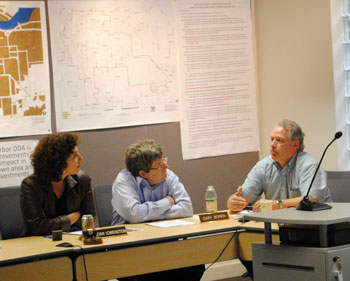
Left to right: DDA board chair Joan Lowenstein, and board members Gary Boren and Roger Hewitt. (Photo by the writer.)
Another main topic of discussion was transportation, which came in the context of recent transportation committee talks with the Ann Arbor Transportation Authority. The discussion with AATA dealt with the possible return of a downtown circulator service [formerly The LINK] and improved service to Ypsilanti, as well as an initial study of bicyclist habits in the downtown area. Related to bicyclists, the board heard from one downtown merchant during public commentary about dissatisfaction with the “art” bicycle hoops, as one example of the DDA’s lack of success in considering the end user in some of its decisions.
The board also mulled over a possible restructuring of its committee structure – currently the board has a transportation committee, a partnerships committee, an operations committee, and a capital improvements committee.
Restructuring those committees is being considered in the context of the possibility that the DDA could begin to take a more active role in development of city-owned surface parking lots downtown. That more active role is one possible outcome of the ongoing city-DDA discussions about the parking agreement under which the DDA operates the city’s parking system. The new structure under discussion would add an economic development and communications committee, while merging the operations and capital improvements committees. [Full Story]
On Saturday, the Ann Arbor Democratic Party hosted a forum for candidates contesting the 18th District state Senate seat: Rebekah Warren, Thomas Partridge, and Pam Byrnes.
Warren and Byrnes currently represent the 53rd and 52nd districts of the House, respectively. Partridge may be familiar to Chronicle readers as a frequent speaker during public commentary at the meetings of various public bodies. Partridge’s remarks are recorded in more than 50 Chronicle meeting reports since the publication’s launch in September 2008.
Each of the three candidates sought to differentiate themselves. Byrnes stressed the fact that her entire work career before being elected to the House had been in Washtenaw County, where she’d gotten to know the specific concerns related to the area, thus contrasting herself with Warren, whose whole career has been in Lansing. For her part, Warren cast her work in Lansing as a positive, saying that it allowed her to actually get things done.
Partridge, who laid claim to being the most senior of the candidates, staked out a position as a reform candidate, and reflected back on the 1960s when he’d financed his college education at Michigan State University – by selling a prize-winning Angus steer.
Audience questions written on cards were administered to the candidates by Jim Leonard of The Ann Arbor Observer. The order of the remarks as presented here reflects the same relative order as they were made at the candidate forum. [Full Story]
Ann Arbor Public Schools Board of Education meeting (June 23, 2010): After an hour-long recess trying to wait out a tornado warning, the Ann Arbor Public Schools (AAPS) board of education conducted the last hour and 15 minutes of its Wednesday meeting in the basement of the downtown library. During its basement session, the board postponed three information items due to the storm, and moved directly to the action items on its agenda.

Board secretary Amy Osinski, center, and board president Deb Mexicotte, assessing the storm to determine how long to recess their meeting. Board secretary Glenn Nelson looks on from the right. (Photos by the writer.)
The board recalled all 191 laid-off teachers via the ratification of a new teacher contract, and authorized the layoffs of the entire AAPS transportation staff by contracting with Washtenaw Intermediate School District (WISD) to provide the district’s busing. AAPS bus drivers and other transportation staff can apply to WISD for jobs.
The board also renewed the district’s food service contract with Chartwells, received an update from state Rep. Pam Byrnes on Michigan’s Race to the Top efforts, and heard a report from The Neutral Zone’s Riot Youth on school climate as experienced by Lesbian, Gay, Bisexual, Transgender, Queer and Questioning (LGBTQQ) youth. [Full Story]
Last summer, the final piece was put in place for a four-way partnership to fund a transportation feasibility study of the corridor from Plymouth Road down to South State Street. The Ann Arbor Transportation Authority board gave approval for its $320,000 share of the study’s $640,00 price tag.
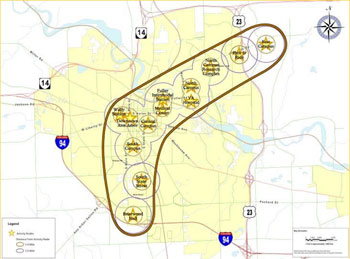
The "boomerang map" showing the Ann Arbor corridors being studied for higher quality transit options like bus rapid transit, streetcars, and monorail. (Image links to higher resolution file.)
Some early results of the “Ann Arbor Connector Feasibility Study” were presented last Tuesday evening at the Ann Arbor District Library in an open-house style format with boards and easels, complemented by a presentation from the consultant hired to perform the study, project manager Rick Nau of URS Corporation.
Nau reported that the study is currently in the needs analysis phase – traffic congestion was a phrase Nau sprinkled through his remarks during the evening. The initial needs analysis shows that the majority of the travel demand in the Plymouth-State corridors is accounted for by trips between different parts of the University of Michigan campus.
The study has not reached the point of drawing lines on maps for possible transportation routes. Instead, the representation of the area of study is a “boomerang map” stretching from US-23 near Plymouth Road to Briarwood Mall. The boomerang includes two of four “signature transit corridors” identified in the city of Ann Arbor’s Transportation Plan Update – Plymouth/Fuller roads and State Street.
Prompted by an audience question, Nau made clear that the study has not yet reached the dollars-and-cents analysis phase that will eventually come. The study is expected to be completed by December 2010 with the preliminary recommendations to be publicly presented in the fall.
Nau’s presentation focused on establishing the need for higher quality transit along the corridor and the range of technology choices available to meet that need. Those technology choices range from larger buses running along the regular roadway to elevated monorail trains. [Full Story]
Ann Arbor City Council meeting (Feb. 1, 2010) Part I: Transportation was a major theme woven throughout Monday’s city council meeting – in part due to a presentation the council heard from SEMCOG’s Carmine Polombo about the Detroit-Ann Arbor commuter rail project. Trains are supposed to begin rolling toward the end of 2010, but Polombo’s presentation made clear that early service would be very limited – day trips and special events – and there are a huge number of unknowns.
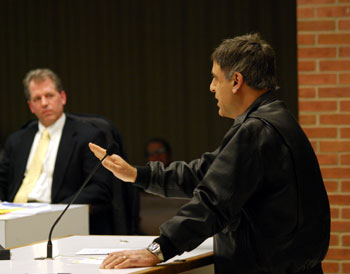
Sol Castell was asked to the podium by Stephen Kunselman (Ward 3) to give an alternate view on the need for a runway extension at the Ann Arbor municipal airport. The topic came up during discussion of the city's capital improvements plan, which wound up being postponed. (Photos by the writer.)
But trains weren’t the only transit-related thread. The city’s bicycle ordinances were updated after having been postponed for a couple of meetings, and a revision to the city’s bicycle registration procedure was tabled and now appears to be on indefinite hold.
The council also approved on first reading a revision to its taxicab ordinance, designed to enforce expectations of larger cab companies.
Also related to transportation was discussion of an item in the capital improvements plan (CIP) for a runway extension at the Ann Arbor municipal airport. After Stephen Kunselman (Ward 3) got his colleagues’ support to amend the CIP to delete the item, the council then voted, with some grumbles of dissent, to postpone consideration of the CIP.
Times and dates for upcoming meetings on the budget were also reviewed, with city administrator Roger Fraser telling councilmembers that the list of possible areas for cuts that city staff had generated were not the only items that could be considered. He challenged councilmembers to come up with their own ideas as well. The council received specific recommendations for budget strategies for the senior center and Mack Pool.
In Part I of the report, we restrict our focus to transportation and budget issues. In Part II, we’ll cover land use issues – including the resolution on 415 W. Washington, which we previewed in our report on the Sunday night caucus, plus a postponement on a greenbelt acquisition. [Full Story]
Typically on the last Wednesday morning of the month, two committees of the Ann Arbor Downtown Development Authority meet back to back – transportation and operations. This past Wednesday was no different.
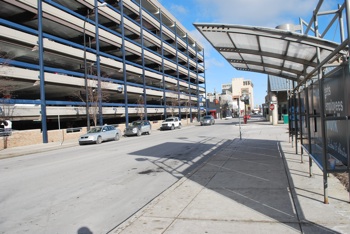
At Fourth & William streets in downtown Ann Arbor. The view is looking to the north. At right is an AATA bus shelter – further in the background on the same side of the street is the Blake Transit Center. Opposite the AATA facilities is a parking deck. (Photos by the writer.)
At the transportation committee meeting, Susan Pollay, the DDA’s executive director, floated an idea for partnering with the Ann Arbor Transportation Authority on improvements to the South Fourth Avenue corridor, between William and Liberty streets. The partnership would include a grant to the AATA in connection with the reconstruction of the Blake Transit Center. No numbers are yet attached to the concept, which Pollay described as a possible “transit mall” – she was checking with the committee for their basic reaction to the idea. That reaction could fairly be described as warm, with some caution expressed by DDA board member Leah Gunn, when she arrived for the operations committee meeting.
Starting last month, the last half hour of the transportation committee’s meeting has been configured to overlap with the operations committee’s meeting, so that the two groups can meet jointly to discuss a directive from the city council to the DDA to deliver a parking plan to the council by April. A preliminary outline of that plan was discussed on Wednesday. [Full Story]
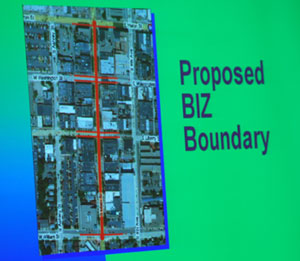
The proposed business improvement zone would include Ann Arbor's Main Street from William Street in the south to Huron Street in the north.
Ann Arbor City Council work session (Oct. 12, 2009): It’s a world where you can throw your newspapers, glass bottles and plastic tubs into one single recyclables cart and set it out for morning collection.
It’s a world where you can then board a bus that drops you off at the train station for your morning commute to Detroit.
It’s a world where during the work day you watch a foot of snow fall, but on your return home to Ann Arbor, you see that the snow hasn’t just been plowed on Main Street – it’s been completely removed – along with those handbills you’d noticed plastered on the lightpost.
It’s a world where later at home, you roll your empty recycling cart back to its place. Then you log on to the internet and see you’ve earned $250 worth of points tallied by the weight of the recyclables that the truck has been recording and crediting for the last year.
At its Monday night work session, Ann Arbor’s city council heard presentations on all the discrete elements of that world, which Ann Arbor could start to resemble in a couple of years. [Full Story]
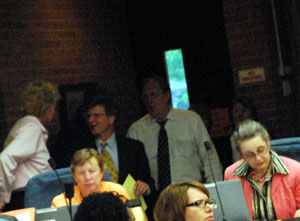
In the background before the council meeting started, Jayne Miller (city of Ann Arbor community services director), Scott Munzel (attorney for the developer of City Place), and Stephen Postema, city attorney.
Ann Arbor City Council Meeting (June 1, 2009): In a move that contradicted expectations based on the previous evening’s council caucus, at which Mayor John Hieftje had indicated that the council would be voting on the City Place site plan, the item was postponed.
The remaining content of the meeting could be roughly divided into two major themes: (i) transportation – from a new transportation safety campaign, to walkable sidewalks, to street closings, to parking meters, and (ii) environment – from an update on the dioxane plume, to imminent demolition of the former Michigan Inn, to another postponement on the proposed plastic bag ordinance.
Receiving no discussion from councilmembers were two items added to the agenda on the same day as the meeting, involving a redirection of some $17 million from VEBA pre-funding into the retirement pension system.
Introductions to council included numerous awards made by the historic district commission as well as the public art commission. Chronicle coverage of the public art commission’s Golden Paintbrush awards will come in a separate article. [Full Story]
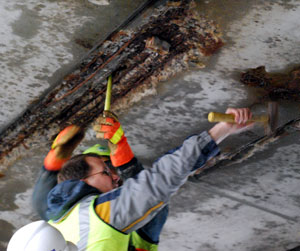
Michael Nearing, an engineer with the city of Ann Arbor, wields a hammer. The hammer was used for two different purposes: "sounding" the concrete for structural integrity and clearing away de-laminated concrete so that it would not fall on cars below.
Since late February, the East Stadium Boulevard bridge over State Street has funneled vehicles across the span in just two of the available four lanes. The lane reduction is a strategy to protect the fifth – counting from the southern edge of the bridge – of the 16 beams in the structure. That fifth beam is “sagging” 7/8 of an inch lower than other beams in the bridge. So traffic is currently restricted to the northern lanes. [Previous Chronicle coverage of the bridge provides additional background.]
In her update to city council in early March, Sue McCormick, the city’s director of public services, indicated that the bridge was being closely monitored in order to verify the safety of the bridge. Here at The Chronicle, we wondered what “monitoring” entailed. [Full Story]
We’ve been talking about getting rid of our car for a long time, and I’ll admit I’m the one who’s been dragging my feet. For me, having a car is a habit – an addiction, really – and unable to go cold turkey, I’ve been edging toward carlessness in nicotine patch-like phases.
Zipcar has driven me into the final phase. We joined in February, and last week I took my first Zipcar excursion to the Ann Arbor Public Schools budget forum at Scarlett Middle School. What a sweet, unremarkable ride it was.
But before we go there, let’s talk a bit about freedom. [Full Story]